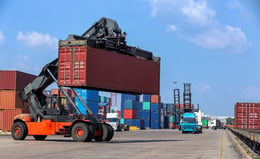The Top 5 Challenges of Logistics 4.0 Adoption
Brian Hoey - March 21, 2019

Let’s say you’re trying to become a healthier person. Seems simple enough, right? You just need to choose healthier foods and exercise a few times a week—it’s just a matter of making a new weekly schedule that includes time set aside for exercise and for cooking a few health-conscience meals. Right? Well, maybe not. When you set down to actually create this new schedule, you realize that you’re not sure how much exercise you’re getting currently or how many calories you’re burning during that exercise. As a result, you determine that you need to get a Fitbit to track to your current exercise levels. By the same token, you find that you need a food scale to help you measure out portions for your new recipes, and you need to do a lot of advanced research on the actual calorie counts and other nutritional information for various foods.
We’re guessing that this is basically the moment that most people will give up. Sure, a healthier lifestyle might be nice, but the effort it takes to get started is just too high for most people, especially when they know that the results aren’t likely to be immediate. As it is with diets, so is it with logistics. The dream of smart, digitized transport logistics isn’t an unattainable goal these days, but many businesses have trouble getting started because there are so many initial hurdles that need to be overcome.
1. Successful IoT Adoption
One of the biggest hurdles that shippers, freight forwarders, and logistics managers need to overcome in order to build toward Logistics 4.0 adoption is the introduction of internet of things (IoT) devices into the value chain. These devices are more commonly associated with industrial and manufacturing processes (as they form the basis of the modern “smart factory”), but they’re just as critical for developing smarter logistics management. By equipping trucks, pallets, containers, etc. with devices that can provide real-time data streams for planners, you can create an environment in which all of your shipments can be monitored in real-time and proactively adjusted in cases of potential disruption or uncertainty. These devices are, ultimately, just like our Fitbit above: they require large, dedicated initial efforts into researching, selecting, and implementing the right hardware options before you can achieve results.
2. Legacy Systems/Low Visibility
Logistics 4.0 provides value in a number of ways, from improved disruption management to increased flexibility across the entire value chain, each of which stems from the same wellspring: E2E (end-to-end) visibility. Without a high level of visibility, all the fancy technology in world won’t help you to improve your logistics operations. In order to achieve the level of visibility we’re talking about, each touchpoint on the value chain must be connected via digital infrastructure to every other point. Legacy systems and data silos that refuse to integrate with newer technologies are often major contributing factors when attempts at increasing visibility fail. As such, organizations hoping to work towards a Logistics 4.0 framework should analyze every facet of their IT systems to ensure that each component helps promote connectivity and visibility across the entire network. Otherwise, you’ll be stuck guessing at important (but inaccessible) pieces of operational data when you’re making future decisions.
3. Client IT Integration
There’s a reason it’s called Logistics 4.0. That reason is that it naturally goes hand in hand with Industry 4.0 systems. While this might be a lot to ask from your clients as a shipper or a freight forwarder, the inability to integrate one’s own IT systems (including relevant data streams from across the value chain) with partner companies' is one of the key factors that prevents successful Logistics 4.0 adoption. Why? Because transport planners lacking in mission critical information are unable to make proactive planning decisions. If you can’t gain information about your clients’ production workflows in order to understand how their schedules interlock with yours, you’re likely to be completely blindsided by any potential disruptions. This means that when a particular shipment isn’t ready for pickup on time, you’ll have no way to assess whether, for instance, you’re better off waiting for their production processes to run their course and making up time elsewhere vs. taking the shipment as is and bundling future runs differently to account for the difference.
4. Defining KPIs
To this point, we’ve mostly spoken about technological barriers to successful Logistics 4.0 adoption. But what about organizational barriers? Often, when businesses fail to achieve smart digital functionality in their transport logistics, the reasons are at least partly related not to technology but to people. For instance, it’s impossible to roll out a Logistics 4.0 workflow successfully without first defining what success will look like. Are you trying to create a more decentralized decision-making structure to improve your disruption response? Are you trying to offer more value to your digitally-enabled clients? Maybe you’re hoping to create a lean or agile supply chain. Whatever your goal is, it should be concrete and measurable. In fact, it should have specific KPIs associated with it that you can track and monitor over time to ensure that your plans are staying on course.
5. Increasing Globalization
Okay, we know what you’re thinking: if globalization itself is a hurdle, how are we supposed to overcome it? And that’s a fair question. The fact is, the increasing complexity of the global value chain makes it harder and harder to achieve real, meaningful visibility across every touchpoint. Likewise, it makes it harder and harder to understand all of your options for choosing routes, setting tours, and partnering with other logistics providers. And the further into the modern, digital, global era in supply chain management we get, the more difficult it will be to gain a complete, cohesive look at the steps that any given shipment can or will take from its point of origin to its destination. This is, at once, a hurdle and an incitement. The longer you wait, the harder it will be to transition to a fully digital supply chain in a way that adds value and minimizes disruption. Pulling the trigger and making the bold choice to do so can be its own sort of hurdle, but it’s one that every shipper and freight forwarder will have to take the leap and make.
If you want to learn more get your Guide to Logistics 4.0
In this Guide you will learn:
-
Why a strategic process in transportation planning is a top priority for digitalization
-
What megatrends will increase supply chain volatility
-
How to manage it
LATEST POSTS
- Understand Circular Economy in The Manufacturing Industry
- How Can Industry 4.0 IT Integration Be Achieved Smoothly?
- The Significance of Order Sequencing in Discrete Manufacturing
- How to improve your Supply Chain Management: The Power of Control Towers
- Optimizing Human Resource Scheduling in Manufacturing: A Technological Approach



